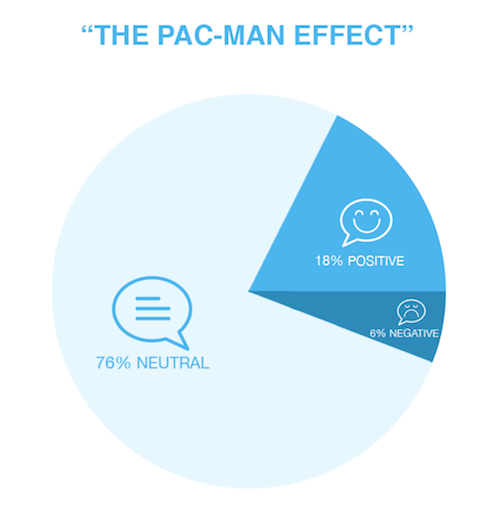Big organizations may have ruined social in some ways. They rushed in at one point trying to be cool, and now your NewsFeed and Timeline and whatever else can be cluttered with stuff about Fritos. This is a potential tipping point, no doubt. I read an article on a plane a few weeks ago — can’t remember the publication, alas — about how some cracker company was doing selfies with their cracker in Times Square, and the best selfie got a personalized selfie from Kelly Osborne. This is a good example of a marketing meeting that hit the f’n wall at about 100 mph, but in which someone said “We need to be cool. Something with selfies, and something with Kelly Osborne!” That person probably makes 2x what I ever will. Meetings rule, as we know.
Was just perusing the Buffer blog and I found this, via a Mention study: when you analyze over 1 billion interactions with businesses on social media, 18 percent are positive, 6 percent are negative, and 76 percent are neutral/transactional (so basic questions about the brand, etc.) That means that 3/4 of all interactions on social with a company tend to be neutral. That’s fairly boring, especially if you add in the fact that 80 percent of individual social users are “me-formers” instead of “informers.”
There’s probably 2-3 main lessons here, as I would see it.
1. If 76 percent of brand interaction on social falls in that neutral category, then your social strategy needs to rest less on engagement / lead generation and more on moving customer service over to social. If Twitter is a customer service channel and you’re dealing with people’s tweets pretty quickly, you’re converting those people into “brand ambassadors,” which is a form of lead generation. Now… the issue here is that only a small percentage of people are actually on Twitter, and probably none from certain generations that still may have questions or be the leading purchasing force in a household. So you can’t abandon traditional forms of customer service, no … but if 3/4 of branded social is neutral, you need to be doing customer service in that space.
2. Ultimately social media needs to be tied to revenue, yes — I had a job interview with NASCAR this spring where a high-up guy told me, “I don’t care what we do on social, so long as we make money” — but this 76 percent figure points to looking at social ROI differently. The goal shouldn’t necessarily be “lead gen” — the funnel is totally shot from how most people are taught it, anyway — but rather, conversion to ambassador status (basically make a potential customer/client feel like you dealt with their question/issue and make them think, “Wow, that’s a good company”). That conversion could lead to e-mail capture, and then you start to get towards lead gen. But sometimes it feels like companies enter the space and assume, “Well, leads will fall into our lap. There’s millions on social!” There are actually several intermediate steps in the process. It’s not conventional 1970s sales and marketing anymore.
By the way, they call this whole 76 percent concept “The Pac-Man Effect” because of what the graph looks like:

